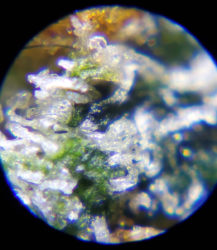by Nebula Haze
A study came out in 2019 (“Impact of N, P, K, and Humic Acid Supplementation on the Chemical Profile of Medical Cannabis (Cannabis sativa L)“) that has important potential implications for home cannabis growers. The study found that supplementing cannabis plants with Nitrogen (N), P (Phosophorus), K (Potassium), and Humic Acid can affect a cannabis plant’s growth patterns and results at harvest. For home marijuana growers, understanding how nutrients and supplements affect your results can help you optimize your garden. Not everyone loves reading science articles as much as I do, so I thought I’d share the results in plain words. Let us know if you have any comments or know of other interesting studies about cannabis plants!
Quick Overview: What findings may be most important to cannabis growers?
Humic acid supplementation during the flowering stage
- lowered THC, especially on buds at the top of the plant (37% THC reduction in top buds)
Phosphorus supplementation during the flowering stage
- reduced overall plant height
- reduced length of buds
- reduced cannabinoid levels in sugar leaves (but not buds)
Keep reading to learn more!
Study: Impact of N, P, K, and Humic Acid Supplementation on the Chemical Profile of Medical Cannabis (Cannabis sativa L)
Read the Full Text of the Study Here: https://www.ncbi.nlm.nih.gov/pmc/articles/PMC6589925/
Review of the Study: What Matters to Cannabis Growers
This article quickly covers the researcher’s findings and talks about the potential impact the information could have on the cannabis growing community (if their findings apply to more than just the one strain they conducted tests with)
Purpose of the Study
- Study how giving extra N, P, K, and Humic Acid affected the results of growing cannabis plants
Study details
- Strain: NB100 – a high-THC strain of cannabis with low CBD content (<0.1% CBD). NB100 is one of the cultivars approved for medical use in Israel, where the study was conducted.
- Plants: There were 6 replicate plants per treatment for a total of 24 plants in the experiment. All 24 plants in the study were clones from the same mother plant.
- Grow environment: Started from clones and grown in pots in a greenhouse under controlled conditions.
- Experiment Design: After plants were 3 weeks old, they were put on a 12/12 light schedule to initiate flowering. The plants were then exposed to one of 4 treatments.
- Control Treatment: a standard commercial nutrient regimen
- Treatment 1: Extra humic acid (+HA)
- Treatment 2: Extra phosphorus (+P)
- Treatment 3: Extra NPK (+NPK)
- Analysis: Plants were harvested after 8.5 weeks of flowering (when this variety is typically ready to harvest) and the following aspects were measured and analyzed via statistical analysis:
- Cannabinoid concentrations in flowers, inflorescence leaves, and fan leaves from different heights of the plants. Concentrations of 11 cannabinoids were quantified using GC-MS.
- Mineral nutrient content in different plant organs by digesting tissue samples with different acids and analyzing using an autoanalyzer or atomic absorption spectrophotometer.
- Physiological parameters like membrane leakage, osmotic potential, chlorophyll content and pigment composition.
- Plant morphology characteristics like height, branch number, organ biomass distribution.
Findings
- Overview of different effects on different parts of the plant
- Supplements affected cannabinoid content in specific organs of the plant, and had different effects on inflorescence leaves (sugar leaves) vs flowers (buds)
- Influenced spatial distribution of cannabinoids in the plant. For example, typically cannabinoids are concentrated the most at the top of the plant, and in some cases supplements could change that gradient.
- Mineral and nutrient levels were changed in an organ-dependent fashion. There did not seem to be a clear association between the mineral content of an organ and the cannabinoid content.
- Supplements affected how plants grew and distributed biomass (what parts got bigger compared to others). For example, Phosphorus supplementation significantly reduced plant height.
- Humic acid caused cannabinoids to be distributed more evenly throughout the plant, but tended to decrease cannabinoid content overall.
- Humic acid
- Significantly decreased THC and cannabinoids in buds, sugar leaves, and fan leaves, especially the buds at the top of the plant which experienced a 37% reduction in THC
- Reduced the natural spatial variability of cannabinoid concentrations within the plants (although there were less cannabinoids overall, it was spread more evenly through the plant)
- Increases mineral nutrients in leaves and stems
- Decreased chlorophyll content in leaves
- Increased phosphorus, potassium, and calcium content in some plant organs
- Phosphorus
- Reduced cannabinoid in the inflorescence leaves (sugar leaves) but not the flowers (buds)
- Increased phosphorus and zinc content in plant organs
- Increased calcium content in buds and sugar leaves
- Decreased plant height, internode length, and inflorescence length
- Increases fan leaf biomass but reduced sugar leaf biomass
- Extra NPK (not organic)
- Increased CBG and lowered CBN in buds and not sugar leaves. However, neither CBG nor CBN is typically present in large amounts, so these changes may not have made a significant difference to bud effects.
- Increases nitrogen, phosphorus, and potassium content throughout the plant, but mostly in the leaves as opposed to the buds
- Increased total shoot biomass
What findings may be most important to cannabis growers?
- Humic acid supplementation greatly lowered THC, especially on buds at the top of the plant
- Phosphorus supplementation reduced overall plant height as well as length of buds (which can reduce overall yield potential), and reduced cannabinoid levels in sugar leaves (but not buds)
Biggest Limitation
- Only studied one strain and all plants were clones, which means that these findings could be strain-specific and not be applicable to other strains
- The effects reported were seen under the specific nutrient supplementation protocols used in the study. It’s possible other concentrations or application methods may produce different results.
- More research is needed before cannabis growers start making major changes to their nutrient regimens!
Abstract:
Mineral nutrition is a major factor affecting plant growth and function. Increasing evidence supports the involvement of macro and micronutrients in secondary metabolism. The use of the appropriate nutritional measures including organic fertilizers, supplements, and biostimulants is therefore a vital aspect of medicinal plant production including medical cannabis. Due to legal restriction on cannabis research, very little information is available concerning the effects of nutritional supplements on physiological and chemical properties of medical cannabis, and their potential role in standardization of the active compounds in the plant material supplied to patients. This study therefore evaluated the potential of nutritional supplementations, including humic acids (HAs) and inorganic N, P, and K to affect the cannabinoid profile throughout the plant. The plants were exposed to three enhanced nutrition treatments, compared to a commercial control treatment. The nutrition treatments were supplemented with HA, enhanced P fertilization, or enhanced NPK. The results demonstrate sensitivity of cannabinoids metabolism to mineral nutrition. The nutritional supplements affected cannabinoid content in the plants differently. These effects were location and organ specific, and varied between cannabinoids. While the P enhancement treatment did not affect THC, CBD, CBN, and CBG concentrations in the flowers from the top of the plants, a 16% reduction of THC concentration was observed in the inflorescence leaves. Enhanced NPK and HA treatments also produced organ-specific and spatially specific responses in the plant. NPK supplementation increased CBG levels in flowers by 71%, and lowered CBN levels in both flowers and inflorescence leaves by 38 and 36%, respectively. HA was found to reduce the natural spatial variability of all of the cannabinoids studied. However, the increased uniformity came at the expense of the higher levels of cannabinoids at the top of the plants, THC and CBD were reduced by 37 and 39%, respectively. Changes in mineral composition were observed in specific areas of the plants. The results demonstrate that nutritional supplements influence cannabinoid content in cannabis in an organ- and spatial-dependent manner. Most importantly, the results confirm the potential of environmental factors to regulate concentrations of individual cannabinoids in medical cannabis. The identified effects of nutrient supplementation can be further developed for chemical control and standardization in cannabis.
Read the Full Text of the Study Here: https://www.ncbi.nlm.nih.gov/pmc/articles/PMC6589925/
Conclusion: More Research is Needed!
This study shows that the supplements we give our cannabis plants can significantly impact their growth, cannabinoid levels, and yields. Humic acid and phosphorus in particular seem to have effects on a cannabis harvest that growers may care about. However, although these findings are interesting and should be investigated further, more research is still needed to fully understand how these supplements impact different strains and growing methods.
Source Paper
Bernstein N, Gorelick J, Zerahia R, Koch S. Impact of N, P, K, and Humic Acid Supplementation on the Chemical Profile of Medical Cannabis (Cannabis sativa L). Front Plant Sci. 2019 Jun 17;10:736. doi: 10.3389/fpls.2019.00736. PMID: 31263470; PMCID: PMC6589925.


